In my paper I’d like to reveal how an ideal of Kyushu has been intentionally constructed through culinary tourism, and with comparisons to other areas of Japan.
1.) Intro of Kyushu, mentioning of Tokyo, Hokkaido and, Okinawa as other culinary tourist hot spots
2.) Relationships of food and foodways, imagined identity, and culinary tourism
4.) Kyushu Tourism Promotion Organization (2005) http://www.welcomekyushu.com/about/index.html
7.) The product: Kyushu’s identity
So I’ve been changing my topic a lot...but basically I seemed to find more evidence that Kyushu wasn’t what I was necessarily trying to prove, but more a carefully constructed image by tourist organizations, the people and, tourists themselves. Therefore I’m trying to use three basic ideas: culinary tourism, foodways and, identity. They seem to work together to create the ideal of Kyushu. Sections 2 and 3 are basically introducing what I’m going to be discussing, the three ideas that I mentioned before and a brief intro of the place (Kyushu) as an island with history where this construction has taken place. 4 is about the tourist organization, why they came about, what their goals are and who they are trying to attract (the audience for this “show”). 5 is therefore the application of this and how it has worked well. I then take that image and compare it Tokyo, just so that we can see where Kyushu stands in the nation (they are near opposites in the what they stand for...) so that builds more to the identity of Kyushu. 7 is just going to be trying to consolidate everything - pulling examples of how Kyushu has seeped into the realm of tourism as a commodity in itself (a restaurant called Kyushu, adding Kyushu to the beginning of dishes etc...).
I’m just not at all secure about this right. It’s something I’m very interested in, but I feel like it will be a lot of me trying to fill in the blanks with my own theories and what not...
1.) Intro of Kyushu, mentioning of Tokyo, Hokkaido and, Okinawa as other culinary tourist hot spots
2.) Relationships of food and foodways, imagined identity, and culinary tourism
- Use Culinary Tourism by Lucy M. Long
- Japanese Foodways, Past and Present Eric Rath
- imagined “community” and identity *****
- media/internet’s role...**** (blogs...possibly Ramen Connoisseurs by Fukutomi )
- basic geography
- Gateway to Asia
- food at ports (Nagasaki, Okinawa, Kagoshima)
- http://www.jcie.org/researchpdfs/Kyushu/KyushuReport.pdf
- a few examples of food in Kyushu now (discussed further ___) NOW
- http://www.welcomekyushu.com/theme/ryori.html (English)
- urbanization*** connecting to rural community through tourism (unique)
4.) Kyushu Tourism Promotion Organization (2005) http://www.welcomekyushu.com/about/index.html
- Food Tourism NOW
- clientele - metropolitan people, foreigners
- hiding industrial Kyushu (takes away from the image) NOWish
- (in talking about the impact of tourism on cultures) “Renewed interest in local culture, appreciation for local traditions, and an improved sense of cultural worth can result.” (6) Culinary Tourism
- Nations will look to future foods (after discovering new ideas about food and shifting) because these are “marketed as foods that a civilized, environmentally aware nation will move toward adopting as s standard part of its cuisine in the future, while simultaneously identifying foods with a preindustrialized, romanticized tribal past.” (28) Culinary Tourism
- farmers markets, agricultural promotion in regions/communities ****
- festivals
- Tokyo’s food scene constructed by customers (targeted?)
- (blogs) http://blog.travelchannel.com/bizarre-foods/2010/06/06/tokyo-its-all-about-the-food/
- (article) http://www.metro.us/newyork/life/article/774902--tokyo-s-exciting-food-scene-in-pictures
- (tokyo tourist information) http://www.gotokyo.org/en/tourists/restaurant/index_restaurant.html
- multinationalism vs. regional pride/urban vs. rural*****
- Kyushu Tokyo comparison:http://books.google.com/books?id=iz06xSmiDqMC&pg=PA106&lpg=PA106&dq=Kyushu+and+Tokyo+regional+differences&source=bl&ots=7Zz_rsmNMk&sig=WcYusIg_4VotIUdGV7TCsZfzqpw&hl=en&sa=X&ei=3-6JUMytGon10gHQm4GgCg&ved=0CDYQ6AEwAw#v=onepage&q=Kyushu%20and%20Tokyo%20regional%20differences&f=false
7.) The product: Kyushu’s identity
- nostalgic, old, traditional****
- Kyushu as Old Japan/ Deep south etc..)
- (ramen tonkotsu in tokyo) http://whiteonricecouple.com/travel/tonkotsu-kyushu-ramen/
- (famous chef makes kyushu fried chicken) http://www.japanesefoodreport.com/2008/05/kyushu-style-fried-chicken.htm)
- specific foods reaching far and wide****
- sweet potatoes, tonkotsu ramen, chanpon, kurobuta...?
- community building through the processes of food NOW
- Taste For Civilization (Flammang), Culinary Tourism (Long)
- becoming Kyushu
So I’ve been changing my topic a lot...but basically I seemed to find more evidence that Kyushu wasn’t what I was necessarily trying to prove, but more a carefully constructed image by tourist organizations, the people and, tourists themselves. Therefore I’m trying to use three basic ideas: culinary tourism, foodways and, identity. They seem to work together to create the ideal of Kyushu. Sections 2 and 3 are basically introducing what I’m going to be discussing, the three ideas that I mentioned before and a brief intro of the place (Kyushu) as an island with history where this construction has taken place. 4 is about the tourist organization, why they came about, what their goals are and who they are trying to attract (the audience for this “show”). 5 is therefore the application of this and how it has worked well. I then take that image and compare it Tokyo, just so that we can see where Kyushu stands in the nation (they are near opposites in the what they stand for...) so that builds more to the identity of Kyushu. 7 is just going to be trying to consolidate everything - pulling examples of how Kyushu has seeped into the realm of tourism as a commodity in itself (a restaurant called Kyushu, adding Kyushu to the beginning of dishes etc...).
I’m just not at all secure about this right. It’s something I’m very interested in, but I feel like it will be a lot of me trying to fill in the blanks with my own theories and what not...


 RSS Feed
RSS Feed